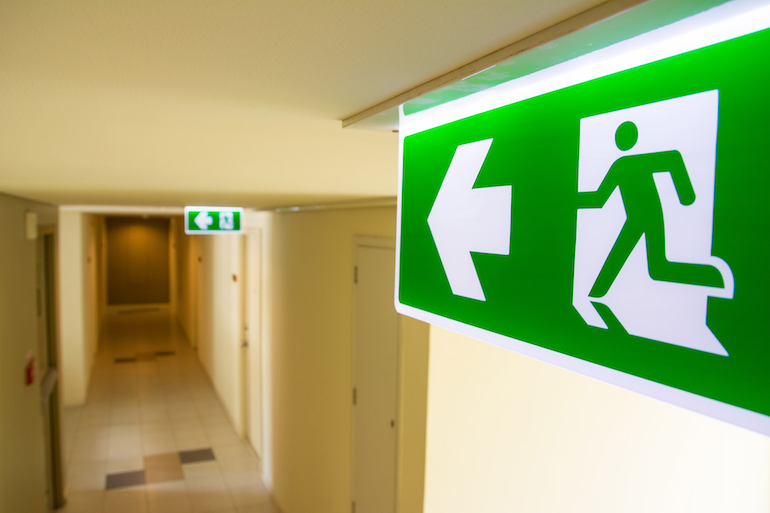New research released this week by the British Woodworking Federation (BWF), as part of its annual Fire Door Safety Week, found that a third (32%) of the British public would not report a problem with a fire door, potentially putting hundreds of lives a year at risk.
Despite three-quarters of people (75%) correctly believing that propping a fire door open stops it performing its role in the event of a fire, 44% wouldn’t take action as are unsure who to report it to while almost half (49%) do not feel it’s their place or role to do so.
Worryingly, half (49%) of respondents said having a better understanding over what fire doors do and how they work would encourage them to take action. In direct response, leading fire and life safety expert Bureau Veritas is urging landlords and facilities managers – particularly those responsible for large multi-occupancy buildings – to create a culture of fire-door safety education and reporting to ensure utmost security for tenants.
The BWF states the ‘Close the Door on Fire’ research findings show there is a ‘clear lack of accountability’ over reporting fire-door issues and that lives are needlessly being put at risk as a result. Shockingly, 44% didn’t know what constitutes a safe fire door, believing either: a fire door is a normal door covered in fire-resistant paint (13%), a fire door is a normal door but with ‘fire door’ signage (13%), or that any timber door was a fire door (7%)
With fire doors most commonly appearing in residential buildings of multiple occupancy, such as an apartment complex or in commercial office spaces, landlords and facilities managers must prioritise a culture of education and open discussion on the topic of fire safety, for the protection of the building and its occupants.
John O’Sullivan, Fire Safety Technical Director at Bureau Veritas, said: ‘Each year, Fire Door Safety Week serves as a timely reminder to landlords, local authorities and facilities managers of the importance of these critical exit routes in the safe evacuation of a building. This year, the focus has turned more towards the responsibilities of tenants in understanding and reporting fire-safety hazards, however the onus cannot solely be put upon them.
‘Landlords of large residential or commercial buildings must put in place a clear reporting pathway for tenants to follow, especially as 44% of those polled said they would not know who to report a fire-safety concern to. In addition, nearly a fifth (18%) of the public said they would be more likely to report fire-door safety issues if there were personal repercussions for not doing so; in this case they must be reminded of the potentially life-threatening consequences of a fire-door safety breach, both on themselves, their family or colleagues, and other people around the building.’
Properly fitted and maintained fire doors are critical to the safe evacuation of a building in the event of fire, forming part of the compartmentation of the building and helping to retain the fire in its area of origin. Poorly fitted, damaged or open fire doors allow smoke and heat into the escape routes within the building, which makes it much more difficult to evacuate and puts lives needlessly at risk. It is of the utmost importance that that each building has an asset register of fire doors to ensure it meets compliance requirements which now forms part of the fire risk assessment process.
Fire-door checks form part of a building’s Fire Risk Assessment and includes a checklist of 42 items to check on each door, including hinges, damage to the frame or door, checks for gaps and the door’s original certification label. If the door and its unit are found to have defects, they will need to be repaired or replaced as well as being re-certified.
John continues: ‘Whilst awareness of fire risk in multi-storey buildings has really come to the fore in recent years, following the Grenfell Tower fire and subsequent Hackitt Review, it is clear from the research that too many members of the British public are still unclear of the proper use of a fire door, and the vital importance of reporting any defects.
‘For landlords or facilities managers who are unsure on how to bring fire-door safety to the attention of their tenants, or the correct procedures to put in place, third-party compliance specialists, like Bureau Veritas, are able to support you in achieving and maintaining compliance, knowing you’ve done all you can to keep your residents safe.’
The specialist fire-safety team at Bureau Veritas offers a range of services including fire-door inspections, acting for the ‘Responsible Person’ to carry out a regular check of fire doors and monitor their condition for effective operation to mitigate the risk of smoke and fire spread in the event of a fire incident.
Fire Door Safety Week was first launched in 2013, in response to a legacy of fire-door neglect, and is managed by the British Woodworking Federation, with support from partners including London Fire Brigade (LFB), The National Fire Chief’s Council (NFCC) and the Home Office’s National Fire Safety campaign.
This year’s initiative has highlighted some concerning statistics on fire-door safety. Research gathered for Fire Door Safety Week found:
- 10% of respondents have seen a propped open fire door in their place of residence on some occasions and 20% in the workplace. The two most common objects used to prop open a fire door are a wedge and a fire extinguisher
- 31% incorrectly believed that a fire door that was propped open was safe and 18% didn’t believe a propped-open fire door poses a risk to those in the building so wouldn’t take action
- 44% didn’t know what constitutes a safe fire door, believing either: a fire door is a normal door covered in fire-resistant paint (13%), a fire door is a normal door but with ‘fire door’ signage (13%), or that any timber door was a fire door (7%)
For more information, click here.


